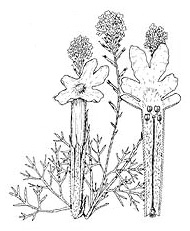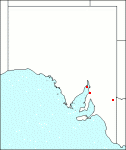Family: Verbenaceae
Verbena tenuisecta
Citation:
Briq., Ann. Conserv. Jard. Bot. Geneve 7-8:294 (1904).
Synonymy: Glandularia tenuisecta (Briq.)Small, Man. Southeast. Fl. 1139 & 1508 (1933).
Common name: Maynes pest, moss verbena.
Description:
Annual or perennial herb; stem and branches semi-creeping to procumbent or decumbent, 10-60 cm tall, tetragonal, shortly pubescent, becoming glabrescent with age; leaves 2-4 cm long, 2-3 cm wide, green, more or less triangular in outline, tripartite-pinnatifid, with segments uniformly linear to subulate.
Inflorescence terminal, pedunculate, spicate, showy; spikes solitary or with several spikes forming a corymb, dense at the apex but elongated at the fruiting stage; flowers sessile; bracts subovate-lanceolate, shorter than the calyx, 2-3 mm long, canescent-pubescent on the back; calyx long-tubular, 6-9 mm long, strigose-canescent throughout with silvery-white hairs, with the tube 5-7 mm long, the lobes 1-2 mm long; corolla showy, varying from blue or bluish-purple to purple-violet or mauve, the tube glabrous, 3-5 mm long, longer than the calyx, the limb 8-10 mm diam., the lobes broadly obcordate, 3-4 mm long, nearly as wide above the middle; stamens and style included.
Mericarps 3-3.5 mm long, reticulate-nervose or -pitted above the middle.

| Flowering branch, flower and opened flower.
|
Image source: fig. 545E in Jessop J.P. & Toelken H.R. (Ed.) 1986. Flora of South Australia (4th edn).
|
Published illustration:
Rickerr (1970) Wildflowers of the United States 3, 2:pl. 110; Cunningham et al. (1982) Plants of western New South Wales, p. 570.
|
|
Distribution:
|
Qld; N.S.W. Introduced from southern America it is now widely cultivated in many countries of the world, mostly under other scientific names such as V. tenera, V. dissecta, V. erinoides, etc. In subtropical and warm temperate areas it tends to become naturalised along roadsides and in otherwise disturbed ground.
|
Conservation status:
naturalised
Flowering time: mainly Aug. — Dec.
|

SA Distribution Map based
on current data relating to
specimens held in the
State Herbarium of South Australia
|
Biology:
No text
Author:
Not yet available
|

